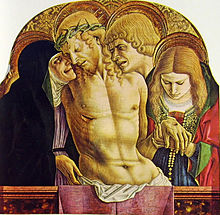Ascoli Piceno Cathedral
The Dom Sant'Emidio in the Italian provincial capital Ascoli Piceno is the cathedral of the diocese of the same name . From Romanesque original structure of the 15th and 19th century is out in the crypt hardly anything to be recognized by changes. The most important piece of equipment is a multi-part retable by Carlo Crivelli . In 1857 Pope Pius IX awarded the cathedral also received the title of a minor basilica .
Exterior construction
A narrow side of the Piazza Arringo is dominated by the wide, rectangular facade of the cathedral, built from travertine between 1529 and 1539 . Its Corinthian colossal order is “designed to give the impression of a simple, robust, but effective simplicity”. Only one of the two planned west towers was completed. On the north side of the nave change classic Renaissance - pilasters with Gothic tracery windows from. The “Musespforte”, a portal in Renaissance form, frames a coffered door dated 1496 .
Interior and outfit
The structure of the three-aisled hall church with an octagonal dome over the crossing is a late Gothic conversion (after 1482) of an original Romanesque building, covered with decorations from the 19th century.
The most important piece of equipment is an altarpiece in the form of a polyptichon , which is located in a chapel on the right. The retable is a major work by the Venetian- trained Carlo Crivelli and was completed in 1473. Several saints are shown, who are arranged in a rectangular field in three registers around the central image with the enthroned Mother of God . Gothic and Renaissance elements form a unit in the framing and painting of this important work.
The high altar from the 19th century integrates older parts in its cafeteria , for example panels in sgraffito technique (cf. similar ones in the cathedral of Ancona ). The choir stalls in the apse are designed according to the late Gothic style at the end of the 15th century with elaborate ornamentation, with the side seats showing more modern motifs than the middle ones.
On the silver antependium from the 14th century, an altar attachment over two and a half meters wide, 27 reliefs depict scenes from the life of Jesus.
crypt
In the eleven-aisled crypt there are spolia from the Romanesque period as well as baroque redesigns. In an altar made of a Roman sarcophagus, the relics of St. Emidius is buried, the patron saint of the city. The plastic representation of the baptizing saint behind it is dated to 1718.
Baptistery
The octagonal baptistery , which was built in the 12th century, also belongs to the cathedral district . It's across the street from the north side of the cathedral. The baptistery is not always open to the public.
Individual evidence
- ^ Basilica Cattedrale di S. Maria Madre di Dio e S. Emidio on gcatholic.org
- ↑ Kauffmann, p. 31
- ↑ Benedetta Montevecchi: Il paliotto d'argento della cathedral di Ascoli Piceno. Note sul restauro conservatio di Tuccio Sante Guido. In: Arte medievale 2/2, 2003, pp. 117-134
literature
- Georg Kauffmann : Emilia-Romagna, Marche, Umbria. (Reclam's Art Guide Italy, Volume IV), Stuttgart 1971, pp. 31–34.
- Roger Willemsen : The brands. Cologne 1996, pp. 310-312.
Web links
Coordinates: 42 ° 51 ′ 12.6 " N , 13 ° 34 ′ 43" E


